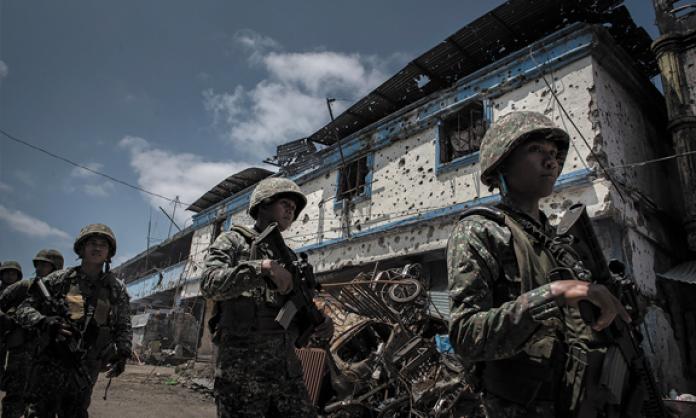The ongoing armed conflict between government forces and Islamist rebels in Marawi, the Philippines, has taken a familiar turn. Evidence is emerging of increased US and Australian military support for the government of Rodrigo Duterte and the Philippine military.
The fighting in Marawi – the capital of Lanao del Sur province in Mindanao – started in May 2017. Philippine military and police remain engaged in a pitched battle with Islamic State-affiliated fighters from the Maute (or Islamic State of Lanao) and Abu Sayyaf groups.
The fighting purportedly began when the Philippine military attempted to apprehend Abu Sayyaf leader Isnilon Hapilon. Maute and Abu Sayyaf forces responded by occupying large areas of the city, leading to a siege and fighting.
The heaviest urban fighting of recent times in the Philippines has destroyed large parts of the city. More than 600 insurgents, 140 government troops and 80 civilians have been killed, with many more wounded and displaced.
Duterte used the crisis as a pretext to declare martial law across the whole of Mindanao. Its 20 million inhabitants have faced increasing repression since May. Duterte has also unleashed a wave of violent repression across the Philippines against small time drug peddlers and the poor.
The Philippine elite’s traditional military and political allies have now re-emerged as crucial backers of the Duterte regime. Despite frictions with the United States in the early part of Duterte’s government, the Philippine military confirmed that there were foreign troops “on the ground” in Marawi in June.
According to the New York Times, the United States also confirmed that Special Forces troops were “providing support and assistance in the southern Philippines”. Armed Forces of the Philippines spokesperson Restituto Padilla added that these military units had “been moved to help ground forces in Marawi”.
According to the Stratfor news service, other military allies have also been involved in the fighting. The United States and Indonesia increased maritime patrols in the area. Australia and Singapore have been providing surveillance and intelligence services. The Australian government has provided two high-tech AP-3C Orion aircraft for surveillance support to the Philippine military.
While much attention has recently focused on Duterte’s increasingly friendly relations with China, it has so far played a limited role. China provided a package of small arms assistance worth $11.7 million. But it remains focused on trade and investment opportunities and is considering what the status of Davao in Mindanao might be in its One Belt, One Path infrastructure initiative.
The presence of Special Forces follows a long history of United States intervention in the Philippines, which is intimately bound up with the current conflict. An occupying colonial power between 1898 and 1947, the United States has continued to act as a security guarantor of last resort for the Philippine elite and its interests.
Widespread resentment over the United States support for the Marcos dictatorship between 1972 and 1986 eventually contributed to a partial retreat of its military presence in the 1990s.
While the 1987 Philippine constitution prohibits the presence of foreign combat troops, the 1951 mutual defence treaty still bound the two countries to provide aid to one another if threatened by a third party.
Although the leases that provided the United States with permanent military bases in the country expired in the early 1990s, a visiting forces agreement allowed for a more or less permanent presence to be re-established.
The Philippine elite historically welcomed this presence. It has confronted threats from major insurgencies from opposition groups over the last five decades. One of these has been conducted by a succession of organisations based among the predominantly Muslim and minority Bangsamoro population in the country’s south.
The origins of the conflict stemmed from the colonisation of the Philippines. The Spanish colonial authorities were able to control most of the archipelago by co-opting tribal leaders and establishing an elite class of landowners between the 16th and 19th centuries.
However, they were never able to gain full control of the areas already governed by Islamic sultanates in the south. It was only with the United States occupation that these areas were integrated into the colonial state. There were also Lumad and other indigenous minority groups. The population has long felt alienated from the Manila-based elite and the larger, predominantly Christian, population.
Waves of “land-hungry” settlers from other parts of the Philippines and increasing political and economic marginalisation caused Mindanao’s population consistently to experience higher levels of poverty and unrest. The incidence of income poverty was still 59 percent of the population (compared to 26.3 percent for the Philippines) in 2015.
These conditions led to and were accentuated by the emergence of armed insurgencies in the late 1960s. The Moro National Liberation Front eventually concluded a peace agreement with the Ramos government in 1996. The breakaway Moro Islamic Liberation Front (MILF) continued fighting until reaching an agreement with Benigno Aquino’s government in 2014.
The origins of the current fighting lie in the failure of these agreements and the rising appeal of rival Salafist groups. The end of the Marcos dictatorship in 1986 resulted in a re-establishment of control by traditional economic and political elites. They have used their power and wealth to control elections and subvert any threats to their power.
Most recently, the elite-controlled Congress prevented the adoption of the Bangsamoro Basic Law to establish a Bangsamoro Autonomous Region.
In any event, some small groups had already broken with the MILF due to disagreements over the settlement. In light of the stagnation of peace efforts, it appears some of them became increasingly attracted to the Islamic State.
Meanwhile, Mindanao’s importance in national politics continued to rise after Duterte (a Christian and former mayor of Davao) was elected president in 2016. While promising a shift to federalism and the implementation of limited social reforms, his regime has instead mostly sponsored widespread vigilante and police violence against small drug dealers. It is estimated to have cost more than 7,000 lives.
While some point to Duterte’s “populism”, he has mostly succeeded in generalising his “warlord” style of governing Davao. He has taken the worst features of previous governments – such as Ramos’ “open for business”, Estrada’s fake social reformism, Arroyo’s widespread use of violence and increased relations with China and Aquino’s “do-nothingism” – to a whole new level.
This has not stopped some sections of the left from fraternising with the regime. Groups and forces aligned with the Communist Party of the Philippines have pursued negotiations. Some figures from groups such as the National Peasant Movement have even sought to head government departments, such as the Department of Agrarian Reform. The negotiations have stalled, and the Congress-controlled Commission on Appointments has vetoed attempts to install these activists.
Small pockets of opposition to Duterte’s government are beginning to emerge and are organising protests actions against the extrajudicial killings. Duterte, however, remains popular. Very few are attracted to or sympathise with the tactics of the Islamic State-aligned groups in Mindanao.
Despite this, it is increasingly clear that no lasting political settlement in Mindanao is possible while political figures such as Duterte – and traditional backers like the US and its allies – continue to dominate national politics. The current challenge is how to develop links between the true defenders of the Bangsamoro people’s rights and the emerging opposition to Duterte.











